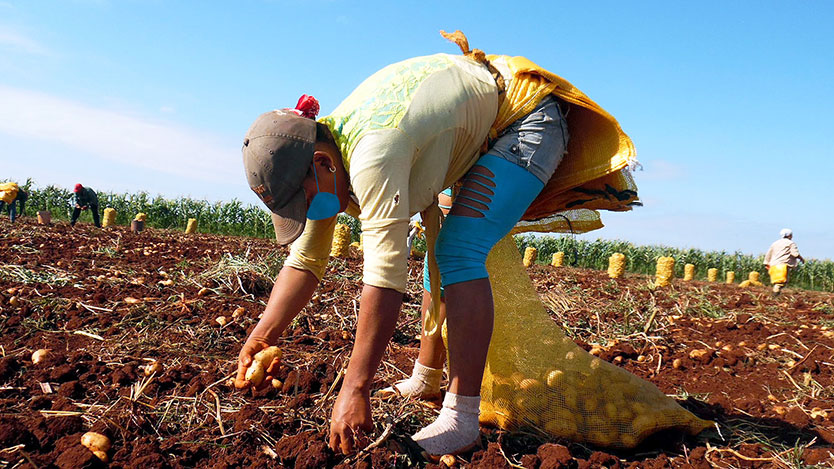
Of the 1,130 hectares of potatoes that were planted in Ciego de Ávila, there were barely 173 left to harvest this Wednesday, but the rain prevented the harvest and increased the rotting of the worst harvest in memory in the last 20 years.
Raúl Monguía Rodríguez, a tuber specialist, shows a potato that would contain less nitrogen to avoid protuberances. Even those oddities were seen in this vintage
If a week ago all the calamities that had befallen the potato seemed like an excess in the last 20 years, the trough that formed in the southeast of the Gulf of Mexico came to show that here we were saying excess to what was not yet. The rains have been so constant that the good weather has not yet come for the earth to dry out and the men can put a boot in the furrow without burying themselves.
However, 15 days ago, when there were about 300 hectares left to harvest, that would have been an impossible task anyway. 34 million plants were estimated in that area. The mobilizations were not enough for such a "norm": they would have rotted before they were removed.
That is why the collecting machines, which came to be 26 between the ones in Ciego de Ávila and those from other provinces, had to do their thing, but bad weather also limited the deployment. Finally, the damage that had been evident since the harvest began in March, was accentuated in mid-May. "Fields of four tons per hectare (t/ha)", Raúl Monguía Rodríguez confesses almost in a whisper.
The specialist in this tuber from the Provincial Delegation of Agriculture was used to yields that hovered around 20 t/ha. They even reached 25 and now the rot has left them withered. In fact, they are descending as a result of an irrefutable logic - more time underground, greater possibility of rotting.
The 173 hectares that remained to be cultivated this rainy Wednesday could make them go down even more. At the beginning of April, they averaged 18.6 t/ha, later, at the beginning of May, they dropped to 12.7 t/ha, and now Monguía updated it to 10 t/ha, while assuring that "this must be the worst campaign of the last 20 years”.
He said, “must” because he did not have the exact number of the worst historical performance in front of him; however, with more than two decades linked to the potato, there is no detail that escapes his memory or question that he evades. He knows that not all the blame came with the waters of this May and the chronology of disasters does not allow him to lie.
The plague of inconveniences has forced to reevaluate quantities and destinations. Las Tunas, for example, received less than half of what was agreed at the beginning of the harvest.
First, soil moisture displaced the start of the campaign. In November, it was not possible to furrow and fertilize the 110 hectares where sowing was to begin, and a delay accumulated. “There we lost 17 days. We had to finish on January 10 and we finished planting on the 27th because, in addition, the imported seed arrived late. On December 30 we were still receiving it and in some varieties we have to wait several days for it to germinate in order to plant them," Monguía explains.
Impact? A campaign that, with this initial delay, was supposed to end at the end of April, bordering on the rainy danger of spring, was attacked with heavy rainfall in April that lengthened the time underground. Already in the middle of that month, the specialist was talking about fields with 40 percent of their area affected. Then, a very rainy May came, the height of evil.
"Why not bring harvesting machines earlier? Because they were from Mayabeque, Cienfuegos and Villa Clara, which at that stage were also harvesting," Monguía answers, guessing the question she supposed would come.
Moreover, as if there were few anomalies, the expert introduces another calamity. “Neither did all the resources enter nor did they enter in time. Only the pre-emergent herbicide entered at 100 percent, although it was not the indicated one. In the case of chemicals, they did not reach 30 percent and there are applications for the thin, round leaf, which are like the Rosefin of humans... By not having it, the fungi flourished and the losses worsened," he confesses.
This total of losses is a figure that we still do not have, but preliminarily we could round it up, even being optimistic. We assume that the 173 hectares that remain to be cultivated will not be more rotten than those that have already been removed and that, therefore, the average yields will not they will continue to drop, they will remain at 10 t/ha.
If 1,130 hectares were planted in Ciego de Ávila, that leaves us with 11,300 tons of potatoes, when the plan was to harvest 22,400. We could have lost half the tuber.
In a few days, we will know how far we descended.




